

Wernher von Braun (1912-1977) was one of the most important rocket developers and champions of space exploration during the period between the 1930s and the 1970s. As a youth he became enamored with the possibilities of space exploration by reading the science fiction of Jules Verne and H.G. Wells, and from the science fact writings of Hermann Oberth, whose 1923 classic study, Die Rakete zu den Planetenräumen (By Rocket to Space), prompted young von Braun to master calculus and trigonometry so he could understand the physics of rocketry. From his teenage years, von Braun had held a keen interest in space flight, becoming involved in the German rocket society, Verein fur Raumschiffarht (VfR), as early as 1929. As a means of furthering his desire to build large and capable rockets, in 1932 he went to work for the German army to develop ballistic missiles. While engaged in this work, on 27 July 1934, von Braun received a Ph.D. in Physics from the University of Berlin.
Von Braun is well known as the leader of what has been called the "rocket team," which developed the V-2 ballistic missile for the Nazis during World War II. The V-2s were manufactured at a forced labor factory called Mittelwerk. Scholars are still reassessing his role in these controversial activities.
The brainchild of von Braun's rocket team operating at a secret laboratory at Peenemünde on the Baltic coast, the V-2 rocket was the immediate antecedent of those used in space exploration programs in the United States and the Soviet Union. A liquid propellant missile extending some 46 feet in length and weighing 27,000 pounds, the V-2 flew at speeds in excess of 3,500 miles per hour and delivered a 2,200 pound warhead to a target 500 miles away. First flown in October 1942, it was employed against targets in Europe beginning in September 1944. By the beginning of 1945, it was obvious to von Braun that Germany would not achieve victory against the Allies, and he began planning for the postwar era.
Before the Allied capture of the V-2 rocket complex, von Braun engineered the surrender of 500 of his top rocket scientists, along with plans and test vehicles, to the Americans. For fifteen years after World War II, von Braun would work with the United States army in the development of ballistic missiles. As part of a military operation called Project Paperclip, he and his "rocket team" were scooped up from defeated Germany and sent to America where they were installed at Fort Bliss, Texas. There they worked on rockets for the United States army, launching them at White Sands Proving Ground, New Mexico. In 1950 von Braun's team moved to the Redstone Arsenal near Huntsville, Alabama, where they built the Army's Jupiter ballistic missile.
In 1960, his rocket development center transferred from the army to the newly established NASA and received a mandate to build the giant Saturn rockets. Accordingly, von Braun became director of NASA's Marshall Space Flight Center and the chief architect of the Saturn V launch vehicle, the superbooster that would propel Americans to the Moon.
Von Braun also became one of the most prominent spokesmen of space exploration in the United States during the 1950s. In 1970, NASA leadership asked von Braun to move to Washington, DC, to head up the strategic planning effort for the agency. He left his home in Huntsville, Alabama, but after about two years he decided to retire from NASA and to go to work for Fairchild Industries of Germantown, Maryland. He died in Alexandria, Virginia, on 16 June 1977.
For more information on von Braun, click here.
Back
 |
 |
Updated May 25, 2006
Steven J. Dick, NASA Chief Historian
Steve
Garber, NASA History Web Curator
For further information, please email histinfo@hq.nasa.gov